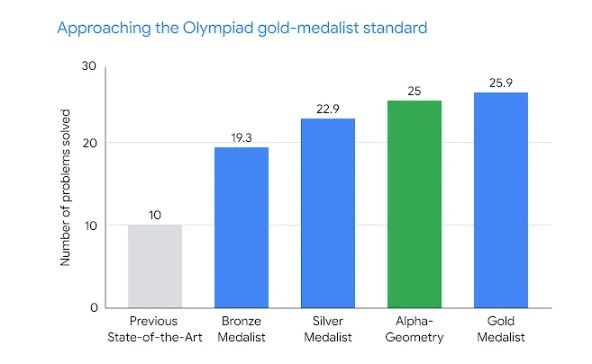 AI
AI
 AI
AI
 AI
AI
Researchers at DeepMind, the artificial intelligence research division of Alphabet Inc., have created software that’s able to solve difficult geometry proofs that are often used to test the brightest high school students in the International Mathematical Olympiad.
The new system, which was outlined in the scientific journal Nature, is said to be a significant advance over earlier AI algorithms, which have previously struggled to replicate the mathematical reasoning needed to tackle geometry problems.
AI researchers, including teams at DeepMind’s rivals Anthropic PBC and OpenAI, have been striving to improve the reasoning and planning abilities of generative AI systems, as these are seen as crucial to creating algorithms that can match the capabilities of humans. It’s believed that if AI systems can be endowed with such skills, they might not only be able to match humans, but even surpass them and make new scientific discoveries of their own.
OpenAI made headlines in November when it was reported that its researchers had made a key breakthrough in creating an AI system that could solve grade school-level math problems it hadn’t come across before. It was a modest achievement, and OpenAI didn’t even confirm it officially, but it created a lot of excitement in the research community anyway.
Now, DeepMind has gone one step further, showcasing a new system that can solve problems at a level comparable to a human gold medalist in the IMO, which is a prestigious competition for high school students.
DeepMind’s geometry-solving AI system combines two different techniques. One component of the software, called AlphaGeometry, is a neural network that’s based loosely on the human brain. Neural networks have been credited with some of the biggest advances made by AI systems, but they alone were not able to solve the most advanced geometry problems.
However, DeepMind paired AlphaGeometry with a symbolic AI engine, which uses a series of human-coded rules around how to represent data such as symbols, and then manipulate those symbols to reason. Symbolic AI is a relatively old-school technique that was surpassed by neural networks over a decade ago.
DeepMind’s researchers explained that the system uses AlphaGeometry to develop an intuition about what might be the best approach to solving a geometry problem. This intuition is then used to guide the symbolic AI engine and come up with solutions. According to DeepMind, the new system was able to achieve results that are on a par with gold medal-winning high school students who compete in the annual IMU challenge.
All told, it was tested on 30 geometry problems, completing 25 within the specified time limit. The previous state-of-the-art AI system, developed way back in the 1970s, solved only 10 problems.

According to the researchers, AlphaGeometry’s proofs were not quite as elegant as those created by humans, and they generally took significantly more steps to solve each problem than most students do. However, they also pointed out that AlphaGeometry developed some unique approaches that may lead to the discovery of geometric theorems that were previously unknown to mathematics. They plan to undertake additional research to determine if this is true.
One of the main challenges of teaching AI systems to solve mathematical problems has always been the lack of training data. DeepMind got around this by taking geometry questions used in the IMO and synthetically generating 100 million similar, but not identical, examples. They then used this dataset to train AlphaGeometry’s neural network, and their success highlights the potential of synthetic data to be used to train other kinds of AI systems where the lack of training data has caused difficulties for researchers.
DeepMind’s researchers said the hybrid neural network/symbolic AI approach may also hold promise for AI in other challenging domains, such as physics and finance. In those areas, problems can be solved using a combination of explicit rules and a more intuitive sense of how those rules should be applied. To encourage further exploration of this concept, it’s open-sourcing AlphaGeometry’s code and training data.
Support our mission to keep content open and free by engaging with theCUBE community. Join theCUBE’s Alumni Trust Network, where technology leaders connect, share intelligence and create opportunities.
Founded by tech visionaries John Furrier and Dave Vellante, SiliconANGLE Media has built a dynamic ecosystem of industry-leading digital media brands that reach 15+ million elite tech professionals. Our new proprietary theCUBE AI Video Cloud is breaking ground in audience interaction, leveraging theCUBEai.com neural network to help technology companies make data-driven decisions and stay at the forefront of industry conversations.